Shep Hyken's Blog, page 97
October 14, 2020
Ritualizing the Customer Experience
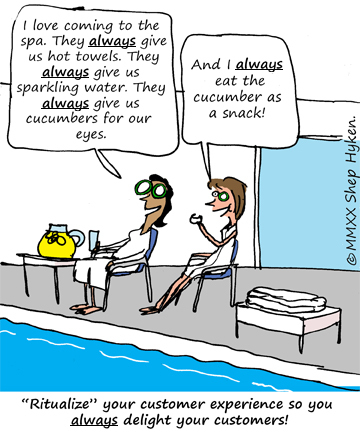 I love hanging around smart people, and my friend Todd Hartley is one of the very smartest.
I love hanging around smart people, and my friend Todd Hartley is one of the very smartest.
He runs WireBuzz, an agency that uses videos to help their clients sell and service their customers, clients, guests, etc.
He was interviewing me for his podcast and used the phrase, “ritualize the experience.” He used it in passing, but I realized this is a rock-solid concept that is appropriate for everyone in any company and any industry. I wrote those three words down so I wouldn’t forget them and then thought about them for the next few hours.
Ritualizing the experience starts by understanding the process around your customer’s experience. This is no different from creating a process or workflow for anything you want to achieve in business. You most likely have a process for paying an invoice. If you have a new vendor, you probably have a process to set them up in your system. There’s a process for just about everything you do in business, and that includes the customer experience.
Even if you haven’t formalized it yet—and after reading this, I hope you will—your process for customer experience is simply the way (or many ways) your customers do business with you. The first time they do business with you may be different than subsequent times. The way they get support is a journey unto itself. Most people would start with a journey mapping exercise to get an understanding of the different ways your customers interact with you. Many of you have done this, but let’s go a step further.
The word ritualizing is a powerful word. When you tie it to customer experience, you’re taking something that’s part of the customer experience—something very positive that you want to happen all the time—and ritualizing it. In other words, you are making sure it happens every time, no matter what.
For example, there is a jewelry store where I bought my wife a gift. Every time I walk in the store, they ask me if I want some bottled water or a glass of wine. They always make this offer. That’s the first thing they do—always—and it helps set the tone for what’s to follow. It is one of their rituals.
Some of you may be familiar with the story of my taxi driver in Dallas. On the way to the airport he asked if I wanted to see the famous fountain at Los Colinas on the way. Reluctantly I said, “Yes,” and I’m glad I did. He was passionate and shared some interesting information about this Dallas landmark. Later, I asked him how often he asks his customers if they want to see the fountain. His response was, “Every time.”
What special moment in your customer’s experience is worth ritualizing? Meet with your team and come up with different points in your customer’s journey where you want something to always happen—something you don’t want to leave up to chance. Then create the process and training that supports this ritual and make it happen every time.
Shep Hyken is a customer service expert, keynote speaker, and New York Times bestselling business author. For information, contact 314-692-2200 or www.hyken.com. For information on The Customer Focus customer service training programs, go to www.thecustomerfocus.com. Follow on Twitter: @Hyken
customer service training programs, go to www.thecustomerfocus.com. Follow on Twitter: @Hyken
(Copyright © MMXX, Shep Hyken)
The post Ritualizing the Customer Experience appeared first on Shep Hyken.
October 13, 2020
Amazing Business Radio: Jason Dorsey
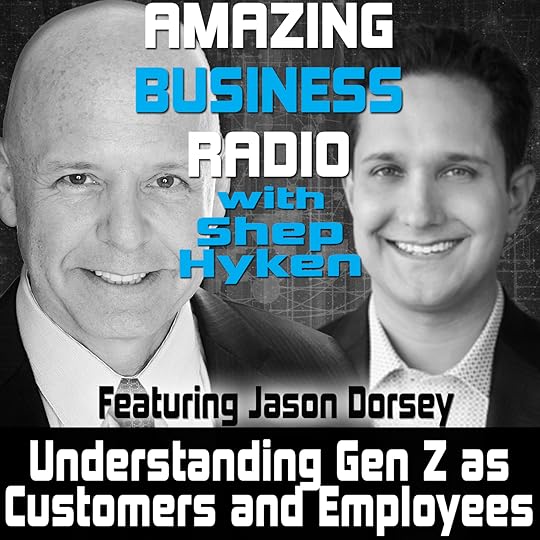
Understanding Gen Z as Customers and Employees
The Next Generation of Customer Experience
Shep Hyken interviews Jason Dorsey, leading generational researcher, speaker and author. They discuss his latest book, Zconomy, and talk about what Gen Z wants as customers from their favorite brands.








Top Takeaways:
To understand Generation Z as consumers is to understand the future of your (and every) business. They are the fastest-growing generation in the workforce, the number one generation of consumer trendsetters (they even influence Baby Boomers!) and the most likely to write positive things online and recommend brands to others.
The oldest members of Gen Z are 25 and most of them do not remember 9/11.
While it’s important not to box people in by generation, knowing a customer’s generation can give you clues that help you better understand them. This, in turn, can help you faster connect, build trust and drive influence with those customers.
When making a purchase decision, Gen Z customers look for a few key things: low price, ease of purchase, ratings and reviews, ease of returns and if someone they know previously made that purchase.
Gen Z wants an experience before they buy something. When they do buy something, price (not the lowest price) is important to them and they always expect a good deal. They will pay more for an all-inclusive experience if they feel it is a better deal than the cheapest option.
Ease of purchase is all about asking yourself how simple you can make something so it just works. Often, this involves utilizing new tech—but be careful not to sacrifice the human connection!
Offering easy returns reduces the risk for online and first-time purchases, which consumers perceive to be very high-risk. Reducing risk helps overcome objection in the sales process.
Ratings and reviews are incredibly important to all consumers, not just Gen Z. Even more important is knowing someone personally who bought that product or service before. Family and friends’ opinions are the most trusted, even if their tastes do not match the purchaser’s.
To understand your consumer base better, create a generational snapshot and put it into a pie chart. Create practical urgency to bring in that next generation to ensure your business lasts.
Quotes:
“Generations are not boxes. Generations are powerful and predictive clues. If you know those clues, you can faster connect with, build trust and drive influence, which is ultimately what customers want.”
“Technology is only new if you remember it the way it was before.”
“Do not view Gen Z as a more extreme version of Millennials. They are completely different. Gen Z is the number one generation to write positive things online, to recommend brands and so forth. If you win them, you win them and their friends. It’s a huge opportunity.”
About:
Jason Dorsey is the President and Co-Founder of The Center for Generational Kinetics as well as a leading generational researcher, speaker and author. His latest book is Zconomy: How Gen Z Will Change the Future of Business—and What to Do About It.
Shep Hyken is a customer service and experience expert, New York Times bestselling author, award-winning keynote speaker, and your host of Amazing Business Radio.
The post Amazing Business Radio: Jason Dorsey appeared first on Shep Hyken.
October 12, 2020
5 Top Customer Service Articles For the Week of October 12, 2020
Each week I read a number of customer service and customer experience articles from various resources. Here are my top five picks from last week. I have added my comment about each article and would like to hear what you think too.
Radical Empathy And Other Ways To Rethink Your Customer Experience by Bridget Brennan
(Forbes) Our world is changing by the minute (or so it seems), but amidst all the disruption, one thing remains constant: women’s domination of consumer spending. That fact alone provides a valuable compass for innovating your customer experience during Covid-19, as well as reimagining what it could look like post pandemic.
My Comment: Let’s start this week’s Top Five with one of the hottest topics in customer service and experience, and that’s empathy. The author includes five customer loyalty strategies, the first one being empathy. That’s what caught my eye. She refers to a deep understanding of your customer as radical empathy. During the COVID-19 pandemic, the concept of empathy has emerged as an important way to communicate with customers, and may very well turn out to be the business “word of the year.”
Four proven ways to foster stronger customer loyalty by Liem Viet Ngo
(UNSW Business School) Managers and marketers who want to boost customer loyalty post-COVID-19 should focus on four key areas, according to UNSW Business School research
My Comment: In my quest to find the best way to create customer loyalty, here is a great article that sets up the importance of going for loyalty followed by four sound strategies. These are very strategic and will make you think. Of course, you want to create a great experience (number four), but you also want to build “equity” with the brand, relationship and value proposition.
Does Ryanair deliver poor service or is it a CX success story? by Sampson Lee
Ryanair has long been criticized for its poor service and is commonly regarded as delivering bad customer experiences. But there’s a train of thought that suggests, contrary to this, Ryanair is in fact a customer experience success story…
My Comment: So, we know that Ryanair doesn’t win awards for great customer service. On the contrary, they are recognized for their poor service. They don’t hide it. If you want a comfortable first-class seat, this airline is not for you. But, if you want the lowest prices, then you’ve found cheap-fare utopia (my term, not theirs). If the value perceived (low fares) is more important than the experience, the value will push the experience aside. Ryanair doesn’t promise you the best service. They promise you a low price. And for them, it works.
13 Ways To Leverage The Trust-Building Power Of Company And Personal Accolades by Expert Panel
(Forbes Agency Council) You can proclaim your value proposition in emails, ads and owned media, but leads will find few things more persuasive than the praise of happy consumers or recognition from industry leaders and peers. Here, 13 members of Forbes Agency Council look at ways of leveraging accolades to maintain customer loyalty while winning new business.
My Comment: A powerful way to build trust with your company is to have your customers evangelize your products and services. Word-of-Mouth marketing, as it is called, is about others testifying on your behalf. Friends, colleagues and even strangers who comment and share their opinions can help build the trust needed to get a customer to want to do business with you. How do you do it? Here are 13 ways from an Expert Panel® put together by the Forbes Agency Council.
Building customer service resilience during continued uncertainty by Paul Selby
(A Customer Service Perspective) As living with the pandemic has become a fact of life, customers’ expectations for great customer service have returned. And with uncertain times still ahead, now is the time to bolster the means of delivering customer service in a resilient and flexible manner to meet those expectations.
My Comment: Paul Selby is an executive at ServiceNow. Somehow he finds time to write articles, it seems weekly about the topic of service and experience. This is an interesting take on how resilient your service is during an uncertain economy, such as the one that COVID-19 has delivered to us. He shares five ideas worth thinking about. Some of this may seem like old news, but today it’s more important than ever.
BONUS
8 Ways to Stand Out in Your Next Virtual Meeting by Shaun Belding
(The Belding Group) This article shares eight of the very basics to remember for your next Zoom (or other virtual meeting) call:
My Comment: It’s not customer service, but it is about creating a better experience for customers and employees – during your next virtual meeting or presentation. We’ve all been seemingly over-exposed to poorly managed online meetings. My thought is that it’s not the online meeting, but the people presenting at these meetings and events. Read this article, and if you’re not using these ideas already, I’ll guarantee you’ll be better at your next virtual meeting. Your customers and colleagues will really appreciate you for the effort!
 Shep Hyken is a customer service expert, professional speaker and New York Times bestselling business author. For information on The Customer Focus
Shep Hyken is a customer service expert, professional speaker and New York Times bestselling business author. For information on The Customer Focus customer service training programs go to www.TheCustomerFocus.com. Follow on Twitter: @Hyken
customer service training programs go to www.TheCustomerFocus.com. Follow on Twitter: @Hyken
The post 5 Top Customer Service Articles For the Week of October 12, 2020 appeared first on Shep Hyken.
October 9, 2020
Guest Post: What Will Customer Experience Post COVID-19 Look Like in Grocery Retail?
This week we feature an article from Corina Mihalache, Business Development Executive at Tokinomo. She writes about changes in the customer experience for grocery shoppers during the COVID-19 pandemic .
As cliché as it may sound, for an understanding of the future, we must always look into the past. Especially since the first half of this year has been crucial in determining the shift in consumer behavior, needs and expectations.
So let’s rewind for a second to see what happened during the last 6 months. Sit down, I’m going to replay bits of this movie for you:
The new coronavirus hits, most countries go into lockdown. Due to “stay at home” directives people start stockpiling on household essentials, average grocery shopping spendings increase by 50%. By this time, one of the retailers’ biggest problems is, ironically, empty shelves and high demand for sanitizing items. Consumers are panicked and they need reassurance of safety measures being taken by retailers.
Fast forward a bit, consumers realize this is not a battle, it’s a war, one that’s going to last longer than expected. So, trying to stay healthy during the Covid-19 Pandemic, consumers start doing their grocery shopping online, most of them saying that they would continue to do so even after the pandemic is gone. Online grocery shopping sees a mindblowing evolution, one that retailers could have never foreseen.
And that brings us to the present, where the Pandemic has become part of our lives. With restrictions being slowly lifted, people find their way back to the stores. Online shopping is easily declining (USA saw an 18% decrease in June versus May) proving once again that Brick and Mortar stores could hardly ever be defeated by a digital revolution, even in times of a serious health crisis.
What do consumers want now? And how can grocery retailers craft a customer experience that fits the new normal? Or, let’s ask the bigger question: how can you prepare for a future that you don’t really know how it looks?
The answer to that is pretty simple. With everything that’s going on, what we fail to understand is that most of the consumers expectations were almost the same even before the crisis. The request for increased safety measures, extra hygiene and social distancing were the only ones added. Consumers wanted most of the things they want now even before COVID-19. This Pandemic only put a bigger pressure on retailers to move faster and stop postponing the adoption of technology for “when we’ll have budgets and time to explore innovation”.
Back to listening to your customer’s needs, here are some of the things retailers should have in mind when they think about the future of customer experience post Covid-19.
Less Friction, Faster Checkouts
If we think in terms of rivalry between online and offline shopping, the checkout process was the ace up online’s sleeve. Amazon has turned the frictionless retail utopia into reality with its ”Just Walk Out” shopping experience in Amazon Go stores. However, the solution is way too expensive to be scaled, so retailers are looking at a combination of technologies, such as computer vision, digital imagery of barcodes or RFID scanning. Covid-19 added the need of eliminating cues in supermarkets in order to comply with social distancing measures. What used to be a nice-to-have asset that created a simplified customer experience, now it’s becoming a must-have technology and a top priority for retailers.
Safety First, Sampling Later
Complying with social distancing measures in grocery stores means monitoring the store occupancy at all times, ensuring fast checkout processes and giving customers the reassuring feeling that they won’t risk their health by coming in to buy a loaf of freshly baked bread. Lately, that meant canceling sampling campaigns and promotions that involved humans. Consumers are wary, they would like to avoid any kind of unnecessary interaction and they are not to blame. That does not mean cutting all kinds of in-store promotional campaigns, because that would have a damaging impact on the overall customer experience.
Instead, there are new technologies out there that can promote products in an interactive way and create a sort of engagement with the consumers that would make them feel intrigued, happy and safe. I’m talking for instance about this Iot device that makes products pop out of the shelves, talk, dance or even sing to the absolute delight of shoppers. A great alternative for canceled promotions and not only. An interactive robotic display solution that most probably mirrors the future of in-store promotions in grocery retail.

An Omnichannel Perspective
Consider this: a recent Harvard Business Review survey of 46,000 shoppers found that only 7% shopped exclusively online, 20% were store-only shoppers, while 73% moved across multiple channels. Now more than ever, with online grocery shopping finally taking off, retailers need to turn their multi-channel strategy into an omnichannel one. What does that mean exactly? By using multi-channel, retailers manage each of them separately: offline, online, loyalty programs, etc. Meanwhile, omnichannel gives retailers a centralized data management system, as all existing channels are synchronized.
What does that mean for the customers? Getting a seamless shopping experience, of course. Let me give you an example of how an omnichannel approach translates to customer experience: the retailer has an online shop and a physical one, so the customer comes inside the store with a wishlist made on the retailer’s app. The phone battery dies and the list is gone. The store cannot help because the online and offline systems are not connected. Customer is not satisfied, the retailer loses the sale. Consider solving this problem in the future: wouldn’t that be amazing?
Greater Personalization
The main trend of the future for grocery retailers is that stores need to become more customer-centric than product-centric. Some of them are already taking steps in that direction, creating spaces where customers can watch a cooking demonstration, join a wine or beer tasting, sip on a coffee while relaxing a bit or, quite the opposite, climb walls or do other more engaging activities.
The future is experiential, that’s for sure. Retailtainment is not just a fancy word, it’s the reality we are going to live in. People are getting busier and busier and time is the most expensive thing we possess. Making it worthwhile and memorable will become the top priority of brands and retailers around the world. If they want to remain competitive and drive sales and loyalty, they must learn to pay more attention to their consumer needs and encompass more customer-oriented activities in their strategy. Customer experience is the battlefield where grocery fortunes are being won or lost. The stakes are too high for players not to give their best.
Corina Mihalache is an in-store marketing and retail technology enthusiast. Corina is also a Business Development Executive at Tokinomo, the most disruptive shelf advertising solution for grocery retail.
F
 or more articles from Shep Hyken and his guest contributors go to customerserviceblog.com.
or more articles from Shep Hyken and his guest contributors go to customerserviceblog.com.
Read Shep’s latest Forbes article: Sixty-Five Percent Of Emails Are Ignored
The post Guest Post: What Will Customer Experience Post COVID-19 Look Like in Grocery Retail? appeared first on Shep Hyken.
October 7, 2020
Customer Disservice
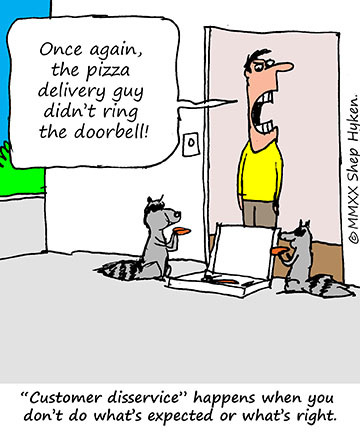 One of our loyal subscribers, Warren Danziger, shared a story about how a delivery was made to his home and placed between the screen door and the front door.
One of our loyal subscribers, Warren Danziger, shared a story about how a delivery was made to his home and placed between the screen door and the front door.
The delivery person never knocked or rang the doorbell to inform him his delivery was there. He was waiting for the package, which contained medicine that was temperature-sensitive. Sitting outside in the heat, baking between the two doors, was not customer service… it was customer disservice. This phrase has no definition. It is not merely the opposite of customer service—that would be bad customer service. This scenario was more like “no customer service.”
In the absence of a formal definition, here’s my interpretation of customer disservice. Put simply, it is the missed opportunity to deliver an expected level of service. In other words, you could have done something to meet or even exceed the customer’s expectations, but failed to take advantage of the opportunity.
Let me share some examples to make this crystal clear.
A customer calls into a support center, and the agent notices something on their account that they could fix. But, because the agent is rushing to end the call as quickly as possible, they don’t ask the customer about it. As a result, they miss the opportunity to help the customer, who will be forced to call back in the future. The agent not taking that extra step is a disservice to the customer.
The sales rep that sells the customer what they ask for instead of what they really need is a perfect example of customer disservice.
A customer goes into a hardware store to buy paint for their home project and gets help from a salesperson. The salesperson could ask if the customer needs any brushes, drop cloths and more for the project, but just focuses on selling the customer the right paint instead. The customer gets home, realizes they forgot to buy paintbrushes and has to return to the store. The salesperson missed the opportunity to sell more to the customer the first time, causing inconvenience—not to mention frustration—for the customer. This is customer disservice.
Sometimes customer disservice happens because someone is taking a shortcut. Maybe they are in a hurry. Perhaps it’s a lack of training to focus on the details of what a customer really needs. The concept behind customer disservice is the missed opportunity. Sometimes this goes unnoticed. If it is noticed, it taints the experience—which could cause the customer to seek out a competitor next time. I think I speak for everyone when I say, “I hate when that happens!”
Shep Hyken is a customer service expert, keynote speaker, and New York Times bestselling business author. For information, contact 314-692-2200 or www.hyken.com. For information on The Customer Focus customer service training programs, go to www.thecustomerfocus.com. Follow on Twitter: @Hyken
customer service training programs, go to www.thecustomerfocus.com. Follow on Twitter: @Hyken
(Copyright © MMXX, Shep Hyken)
The post Customer Disservice appeared first on Shep Hyken.
October 6, 2020
Amazing Business Radio: Steven Van Belleghem
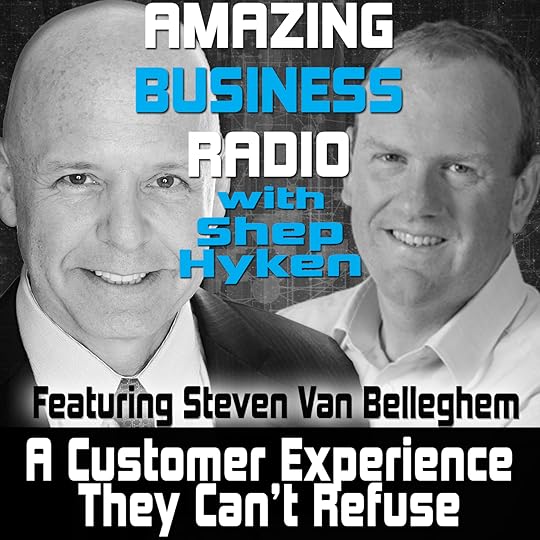
A Customer Experience They Can’t Refuse
Changing the World One Customer Experience at a Time
Shep Hyken interviews Steven Van Belleghem, an expert in customer experience in a digital world. They discuss his latest book, The Offer You Can’t Refuse, and the four factors that go into amazing customer service.








Top Takeaways:
The year 2020 has thrown us into the future technologically. This creates many new opportunities for companies to make their customers happy and make their lives easier.
Customers increasingly expect companies to take a stance on social issues. Remaining silent is no longer an option. Companies must have a point of view, share it with the world, take action and be transparent about the journey.
Companies don’t need to change the whole world to make a positive impact; they just need to change their Find your company’s strengths and leverage them to tackle concrete challenges in society that matter to you.
As a bare minimum, you must offer a good product for a good price and with good customer service. In the past, this was all it took to make customers happy. Today, they expect more.
To be truly successful, companies must know how to create convenience for their customers, especially digital convenience.
A good, working digital interface is a necessity. It must help customers save either time, money or energy (or, ideally, all three)—the resources that no one ever has enough of.
Look beyond your product and think about the human being that is your customer. Become a partner in their life by asking how you, as an organization, can add value to their life. This is the future of customer experience.
Identify the tradeoff your customers must make when they buy from you or any company in your industry. What can you do to reduce or even eliminate it? Develop a process and make it part of your mission statement and brand identity.
Quotes:
“Companies don’t have to change the world. They just have to change their world. Look at the strengths of your organization and see how you can leverage them to solve the concrete challenges in society. This is your responsibility as a business owner.”
“If you have a good digital interface, people think it’s the most natural thing in the world. The further we go into the future, the more that good, working digital interfaces will become as normal as breathing and as having access to electricity.”
“Become a partner in life to your customer. Think beyond the product and about the human behind the customer. Understand the life movie your customer has playing in their head. How can you add value to that movie?”
About:
Steven Van Belleghem is a co-founder and board member of nexxworks. He is an entrepreneur, an international keynote speaker and the bestselling author of four books. His latest book, The Offer You Can’t Refuse, comes out on October 28, 2020.
Shep Hyken is a customer service and experience expert, New York Times bestselling author, award-winning keynote speaker, and your host of Amazing Business Radio.
The post Amazing Business Radio: Steven Van Belleghem appeared first on Shep Hyken.
October 5, 2020
5 Top Customer Service Articles For the Week of October 5, 2020
Each week I read a number of customer service and customer experience articles from various resources. Here are my top five picks from last week. I have added my comment about each article and would like to hear what you think too.
Forever-Changed Buying Patterns Mean Rethinking Customer Loyalty by Mary Jo Yafchak
(Street Fight) The new consumer buying trends — and the business measures put in place to adapt to them — will likely become a permanent fixture even as the economy enters a recovery phase.
My Comment: Just when you may have thought you understood your customers’ buying patterns, along comes COVID-19, disrupting everything we had learned about our customers over the years. Now they have an entirely different pattern and behavior. Time to pay attention and meet your customers where they are. You must adapt to the new way of doing business. They already have, not because they wanted to, but because they had to. This is a very short article but consider its main message.
Customer Service Week is October 5-9: Learn 5 Ways to Celebrate Your Virtual Agents When They Need it Most (Thanks, 2020) by Veronica Krieg
(Sharpen Technologies) 2020 didn’t cancel National Customer Service Week. The festivities are set for October 5-9, and it’s up to you to celebrate your team, no matter where they’re working.
My Comment: Customer service week starts today, October 5, 2020! This excellent article shares a few ideas on what you can do to celebrate the front line, as in support center. They are the ones that take care of the customers, so let’s “love on them” a bit more than normal this week!
7 Ways to Earn and Build Customer Loyalty for Your Business by Brian Meert
(AllBusiness) How do you become the chosen brand? Let’s explore the ways you can cultivate loyalty with your customers.
My Comment: While there may not be much new in this article, it still has some powerful reminders of what’s important in creating customer loyalty. I especially like number seven, which is to focus on being convenient. (I like it so much, I wrote an entire book on just that very topic!)
Are You Delivering Concierge Customer Service? by Chip Bell
(Forbes) I love my work role and have for many years! However, sometimes I get the question: “If you could do any work role you wanted other than your current role, what would it be?” I always say, “A concierge in a busy upscale hotel.”
My Comment: The concept of a concierge is not limited to the hospitality industry. Delivering a concierge style of service implies that the customer will be receiving a higher level of service. And, in most businesses, that is the type of experience that could get the customer to come back – and maybe even become loyal!
How to rethink customer and employee experience: 4 strategies by Donna Tuths
(The Enterprisers Project) In response to the COVID-19 pandemic, CIOs and other C-suite leaders must transform how they think about “experience” – for both customers and employees – or risk losing them.
My Comment: We end this week’s “official” Top Five roundup – other than the bonus articles included below – with an article that focuses on the employee experience. I’ve always felt that internal customers, as in colleagues you work with, are to be treated the same way as your outside customers – maybe even better. Here are a few ideas to get you started.
BONUSES
The Future Of The Customer Service Workforce: A Case Study With CommunityWFM by Matt Wujciak
(CCW Digital) While the pandemic has taken its toll on thousands of organizations, certain business trends were already starting to negatively impact specific industries.
My Comment: What will customer service – and specifically the contact center – look like in the future? Matt Wucjiak of CCW gives a look into the future.
10 Things We Learnt About Customer Experience From Shep Hyken by Team Vue.ai
(Vue.ai) Shep Hyken spoke to us about the ever evolving nature of customer experience and loyalty, in context of the COVID-19 pandemic.
My Comment: Not that long ago I was interviewed for a podcast. Here is a recap of ten of the questions. This was a great interview. Hope you enjoy – and learn!
3 Memorable Quotes from The Convenience Revolution by Shep Hyken by Jeremy Watkin
(Customer Service Life) In this article, I’m happy to share a few of my favorite insights from his book, “The Convenience Revolution.” The basic premise of the book is that the more convenient you make life for your customers, the more they will continue to do business with you.
My Comment: I’ve known Jeremy Watkin for at least five or six years. He’s not only great at what he does – running support centers – but has become a recognized thought leader in the customer service and CX industries. I’m honored that he would take the time to post a summary of The Convenience Revolution, which is all about being easy to do business with. Thank you, Jeremy!
 Shep Hyken is a customer service expert, professional speaker and New York Times bestselling business author. For information on The Customer Focus
Shep Hyken is a customer service expert, professional speaker and New York Times bestselling business author. For information on The Customer Focus customer service training programs go to www.TheCustomerFocus.com. Follow on Twitter: @Hyken
customer service training programs go to www.TheCustomerFocus.com. Follow on Twitter: @Hyken
The post 5 Top Customer Service Articles For the Week of October 5, 2020 appeared first on Shep Hyken.
October 2, 2020
Guest Post: 5 Unexpected Uses for Customer Data
This week we feature an article from Anthony Kreychmar, founder and CEO of Fortuna Visual Group. Learn how to best prepare your contact center for the holiday season .
The rise of technologies and deep penetration of automation in the business sectors has transformed the way brands interact with customers. What is more, all these have changed our everyday life. We expect to receive personalized service everywhere – even if we are talking about the devices in our home. It seems that the dream of having what you want before you even say it is almost at our doorstep.
Customer data analytics is possible due to the rise of IoT, Big Data, and, of course, AI. The technologies will continue to evolve. For instance, Statista estimates that the global AI software market will grow approximately 154% year-over-year in 2020. Therefore, it’s time to unleash the real power of customer data. With its help, you can:
1. Identify Events or Special Occasions
A customer database is an effective tool to connect with your clients and learn meaningful insights about their life. The usage goes far beyond personalized advertisement or targeting. You have a chance to get to know when customers like to shop and why they do that.
For example, if a senior from Canada is ordering a delivery of a toy for a 5-7-year-old boy to San Francisco, you can assume that it’s a grandson’s birthday. By knowing this, you can send a special offer next year. It’s better to do that about one month before the special date.
2. Make Up the List of Likely Product Affinities
Being in customer business, you have to be able to predict what a client wants before he knows it. How to do this? First of all, a brand needs to analyze the combination of purchases. For example, if a client orders a lavatory blade or swing sign -especially if he needs several – you can assume that he is launching a new facility. Offer him a banner for the grand opening.
3. Personalize Healthcare
Wearable devices open new horizons for customer data management. They track every single aspect of your wellbeing and can even make personal diagnoses. In the future, we are likely to take even precision meds.
4. Create the Ideal Atmosphere in a Smart Home
Smart devices learn your habits. They play the music you are likely to enjoy, find movies according to your preferences, and can even show you the best deals from the local restaurants. With the evolution of IoT and AI, a smart home will be able to create the atmosphere you like. It can dim the lights, automatically play the music once you enter, and so much more.
5. Connect with Customers on a Deeper Level
It’s well-known that businesses use Big Data to target customers. Now they can do more. Special equipment can analyze a customer’s mood and adjust on-site advertisements and music to match his inner state.
Customer data makes our world client-oriented. Personal needs and desires are at the forefront. All this is likely to make our life happier and more meaningful. What do you think about customer data and opportunities for its usage?
Anthony Kreychmar is a former marketing specialist. He decided to change his specialty and received a diploma in an IT specialty. His marketing background and deep knowledge of the advanced technologies allow him to provide customers with meaningful insights. Moreover, he advises how to utilize them.
F
 or more articles from Shep Hyken and his guest contributors go to customerserviceblog.com.
or more articles from Shep Hyken and his guest contributors go to customerserviceblog.com.
Read Shep’s latest Forbes article: What Customers Want…And Don’t Want – A Special Article For Customer Service Week
The post Guest Post: 5 Unexpected Uses for Customer Data appeared first on Shep Hyken.
September 30, 2020
Customer Service Week: A Time to Celebrate Customers AND Employees
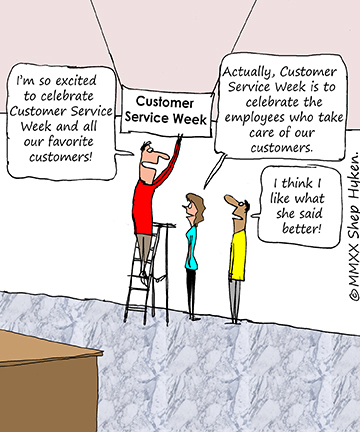 It’s my favorite time of year… the leaves change from green to gold to red, there’s a chill in the air and the holidays are right around the corner.
It’s my favorite time of year… the leaves change from green to gold to red, there’s a chill in the air and the holidays are right around the corner.
And of course, one of my favorite “holidays” is National Customer Service Week, which happens the first full week of October each year. This year it’s October 5-9. Traditionally, Customer Service Week has been the time to highlight and celebrate the great work employees do to take care of their customers. I also believe it’s a time to think about our customers as well.
With that in mind, as this week approaches, now is a great time to ask an important question: What do customers want? Simply, customers want a good experience, and customer service plays a big part in that. It’s more than just the front line interacting with customers. If you have been following my work, you know my belief is that customer service is not a department—it’s a philosophy that is part of an organization’s culture and is everyone’s responsibility. Every employee has an impact on the customer service and the customer experience an organization provides.
So, the next question is what influences a good customer experience? We surveyed over 1,000 consumers as part of our 2020 Achieving Customer Amazement Survey and asked them just that. The top response, with over 65% of respondents in agreement, is that people just want to be treated like a valued customer—with kindness, respect and dignity. Customers are people, not account numbers.
Customers also want the customer service representatives they speak with to demonstrate knowledge and expertise—both about the products and services the company provides, and also about the customers themselves. They want the agents to provide quick solutions to their problems without having to give repeat information over and over again. That goes a long way toward creating a great customer experience.
On the flip side, what influences poor customer service? It’s useful to know what to avoid. The responses we got were pretty common sense (but of course, common sense isn’t always so common!). Rudeness and apathy, not being treated like a valued customer, lack of knowledge and expertise, slow response times and having to repeat information were the top pain points for customers. You’ll notice that these are the opposite of what customers say creates a good experience. Again, common sense.
I’d like to leave you with one final word on this subject—or rather, three words. We asked our respondents to share the three words they felt best exemplified good customer service. The results? Fast, helpful and friendly. This is huge. “Fast” is about creating a convenient experience, something I wrote an entire book on. “Helpful” is about getting answers to questions and solutions to problems. And “friendly” is all about that personal touch—an empathetic human connection—which is even more important than ever these days.
As we move into Customer Service Week, I invite you to remember this information. Share it with your colleagues and employees. Remember, it’s within everyone’s reach to create customer amazement. Without customers, we don’t have a business, but without employees, we can’t take care of our customers.
Shep Hyken is a customer service expert, keynote speaker, and New York Times bestselling business author. For information, contact 314-692-2200 or www.hyken.com. For information on The Customer Focus customer service training programs, go to www.thecustomerfocus.com. Follow on Twitter: @Hyken
customer service training programs, go to www.thecustomerfocus.com. Follow on Twitter: @Hyken
(Copyright © MMXX, Shep Hyken)
The post Customer Service Week: A Time to Celebrate Customers AND Employees appeared first on Shep Hyken.
September 29, 2020
Amazing Business Radio: Claire Boscq-Scott
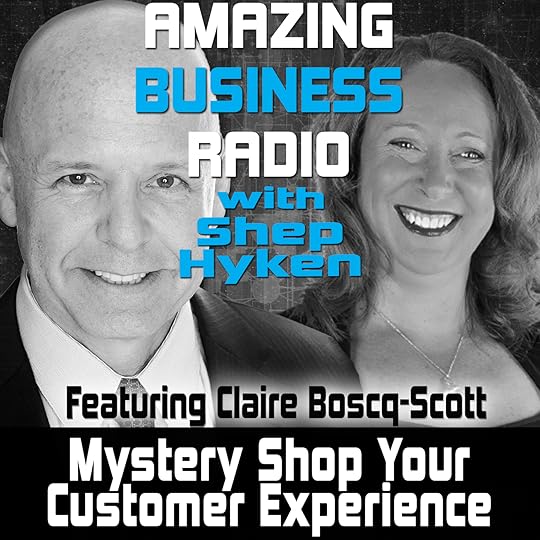
Mystery Shop Your Customer Experience
How to Improve Your CX by Putting People First
Shep Hyken interviews Claire Boscq-Scott, Mystery Shopping and Customer Service Specialist. They discuss her latest book, The Secret Diary of a Mystery Shopper, and how any and every company can and should implement a program to measure their customer service.








Top Takeaways:
It’s important for any and every business to measure the level of service they provide. After all, you can’t change what you don’t measure. Mystery shopping is one method of measuring the customer experience a business provides.
When designing a mystery shopping or other measurement/feedback program, it’s important to first understand what you’re trying to measure.
Follow the customer journey as closely as possible to get the best read on what the customer experience is like.
Mystery shopping and measurement programs are effective everywhere—in both B2B and B2C businesses and both inside and outside the organization.
Measuring your customer service and experience gives you an objective perspective of what works and what doesn’t work.
Once you get your results, you must use them. Develop new strategies and implement training where it’s needed. Continue to measure. Identify gaps and celebrate success. Over time, this will vastly improve your CX.
Design and roll out an internal program before an external one. In other words, focus on your employees and their experience first. Get everyone in alignment with your mission and how they play a part in the customer journey.
Remember that the beliefs and behaviors of leaders and managers will be passed on to employees. Leadership must model the actions and attitudes they want to see in their employees. It starts at the top.
Now, more than ever, companies must take care of their customers, across every touchpoint and channel. Start by putting people (employees and customers) at the center of your business and show that you truly care.
Quotes:
“Being able to measure customer service gives you feedback on where to develop new strategies and implement training. Then, measure again to identify gaps and celebrate success.”
“It really is important to roll out an internal customer service program before you roll out your external program. Make everyone aware of what is expected of them. Give employees the tools for them to deliver great, exceptional, amazing service, inside and outside the organization.”
“Now more than ever, businesses have to take care of their customers. There’s never been a more important time. Whether you’re online or offline, looking after your customers is a priority.”
“Every single leader needs to start caring more for their employees, putting them in the middle of everything they do. Celebrate what they’re doing right, give them the tools to do their job, and really show that you care.”
About:
Claire Boscq-Scott is keynote speaker, consultant and trainer specializing in retail and hospitality with over three decades of mystery shopping and customer service experience. She is the author of three books, the latest of which is The Secret Diary of a Mystery Shopper.
Shep Hyken is a customer service and experience expert, New York Times bestselling author, award-winning keynote speaker, and your host of Amazing Business Radio.
The post Amazing Business Radio: Claire Boscq-Scott appeared first on Shep Hyken.





